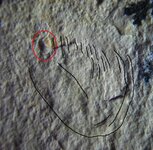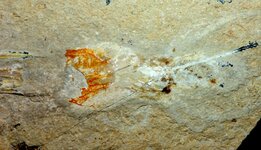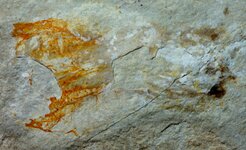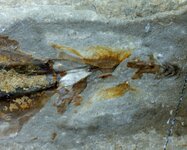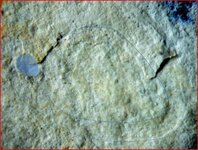Is there any evidence that there was a hard structure around the eyes (like our eye sockets)? I have only dealt with a few dead octopuses but they turn to jelly (and are slimy, unlike the ones I keep when they are alive). It would not seem possible to make an impression like that from these creatures so it makes me wonder if something has changed in that area over time. It might be interesting to expeiment with plaster of paris on an unpreserved dead octopus (if I can find somewhere to put it where it won't be offensive or attact the dogs) to see what impression would be left after the animal decays.
You are using an out of date browser. It may not display this or other websites correctly.
You should upgrade or use an alternative browser.
You should upgrade or use an alternative browser.
More Lebanese soft bodies
- Thread starter Hajar
- Start date
- Joined
- Mar 7, 2009
- Messages
- 542
The preservation of soft parts like these happens when carcasses escape scavengers, are quickly buried and are quickly recorded by the precipitation of minerals such as francolite or pyrite. In only a very few deposits were these requirements met and the laminated limestone of the Lebanese Cretaceous is one of them.
- Joined
- Oct 19, 2003
- Messages
- 3,111
dwhatley;166134 said:Is there any evidence that there was a hard structure around the eyes (like our eye sockets)?
All (extant) cephalopods have a cartilaginous structure that cradles the brain ("consolidated ganglia"?) as well as the eyes to some extent. In squid it can be a proper socket, in which for instance the statoliths are also incorporated.
Here, please find (half of) the eye socket of a subadult Mesonychoteuthis, for reference.

Copyright Te Papa Museum, Wellington, New Zealand
And its associated "sclerotic ring", holding the spherical lens in place. (My apologies for the image being barely focused)

Copyright Te Papa Museum, Wellington, New Zealand
- Joined
- Dec 20, 2009
- Messages
- 961
Great pictures and explanation ob, it really helps me to understand what I am seeing when I look at the fossils. 
Does anyone know what the age of the oldest recorded soft parts are?
Does anyone know what the age of the oldest recorded soft parts are?
Ediacaran 635 Ma to 542 Ma, the period before the Cambrian, has fossils of soft bodied animals, though probably not actual soft parts, more just impressions. And the Burgess Shale (and a few others) of Cambrian age preserves soft parts in very fine detail, as Hajar says, with the right conditions.Terri;166303 said:Does anyone know what the age of the oldest recorded soft parts are?
Could the indentation circled in red below be a mold of the statolith ?ob;166258 said:In squid it can be a proper socket, in which for instance the statoliths are also incorporated.
Attachments
- Joined
- Mar 7, 2009
- Messages
- 542
Thanks Ob,
The "sclerotic ring" you show looks like a good match for the structures very occasionally seen in these Lebanese Cretaceous coleoids.
Here attached are some images of a Dorateuthis head (arms reach about 35 mm, buccal mass about 10 x 10 mm) and a Rachiteuthis head, beak visible at right hand side. What can you see in these in the light of your knowledge of the modern anatomy?
Terri, speaking of cephalopods, it has been suggested that the Middle Cambrian soft-bodied Nectocaris is a cephalopod (not everybody agrees), there have been suggestions that X-ray images of pyritized orthocones from the Middle Devonian Hunsruck Slate show soft parts (not convincing, and at least in some cases misinterpretations) and then we have the Upper Carboniferous Mazon Creek with Jeletzkya and Pohlsepia preserved in ironstone concretions.
Back in the Precambrian, Ediacaran fossils preserved beneath volcanic ash in Newfoundland have been dated at about 575 million years.
That's a real feature you circle there Kevin. I'm going to have to google "statolith" for some images, but what do you think Ob?
The "sclerotic ring" you show looks like a good match for the structures very occasionally seen in these Lebanese Cretaceous coleoids.
Here attached are some images of a Dorateuthis head (arms reach about 35 mm, buccal mass about 10 x 10 mm) and a Rachiteuthis head, beak visible at right hand side. What can you see in these in the light of your knowledge of the modern anatomy?
Terri, speaking of cephalopods, it has been suggested that the Middle Cambrian soft-bodied Nectocaris is a cephalopod (not everybody agrees), there have been suggestions that X-ray images of pyritized orthocones from the Middle Devonian Hunsruck Slate show soft parts (not convincing, and at least in some cases misinterpretations) and then we have the Upper Carboniferous Mazon Creek with Jeletzkya and Pohlsepia preserved in ironstone concretions.
Back in the Precambrian, Ediacaran fossils preserved beneath volcanic ash in Newfoundland have been dated at about 575 million years.
That's a real feature you circle there Kevin. I'm going to have to google "statolith" for some images, but what do you think Ob?
Attachments
- Joined
- Dec 20, 2009
- Messages
- 961
Thanks Kevin and Hajar, that will give me a lot of reading to do! I will also have to look up "statolith"!
All I know it that it is tiny and used to determine age so you made me go looking for more. I think it has something to do with knowing where up is in the water column (since they don't blow bubbles) and I think if functions something like our inner ear. This is what I found in an abstract: http://www.sciencedirect.com/scienc...c7cb8c8443a8eadbf411112dbee686a3&searchtype=a
Post #107 in this thread, Steve describes the statolith of Architeuthis. Unfortunately the pics disappeared in the Great Photo Extinction Event of 2004. 
- Joined
- Mar 7, 2009
- Messages
- 542
- Joined
- Mar 7, 2009
- Messages
- 542
and thanks for the abstract D. I couldn't see any hint of growth increments in the fossil.
- Joined
- Mar 7, 2009
- Messages
- 542
- Joined
- Oct 19, 2003
- Messages
- 3,111
For further reference, this is the statolith taken from a 1,85 meter ML Architeuthis specimen, held up in a test tube by Tsunemi Kubodera following extraction; they are pretty close to being the proverbial needle in the equally proverbial haystack.

Copyright Te Papa Museum, Wellington, New Zealand

Copyright Te Papa Museum, Wellington, New Zealand
- Joined
- Oct 19, 2003
- Messages
- 3,111
I wonder whether their "growth rings" would also fossilize, time to look into the literature...
- Joined
- Mar 7, 2009
- Messages
- 542
Similar threads
- Replies
- 14
- Views
- 351

